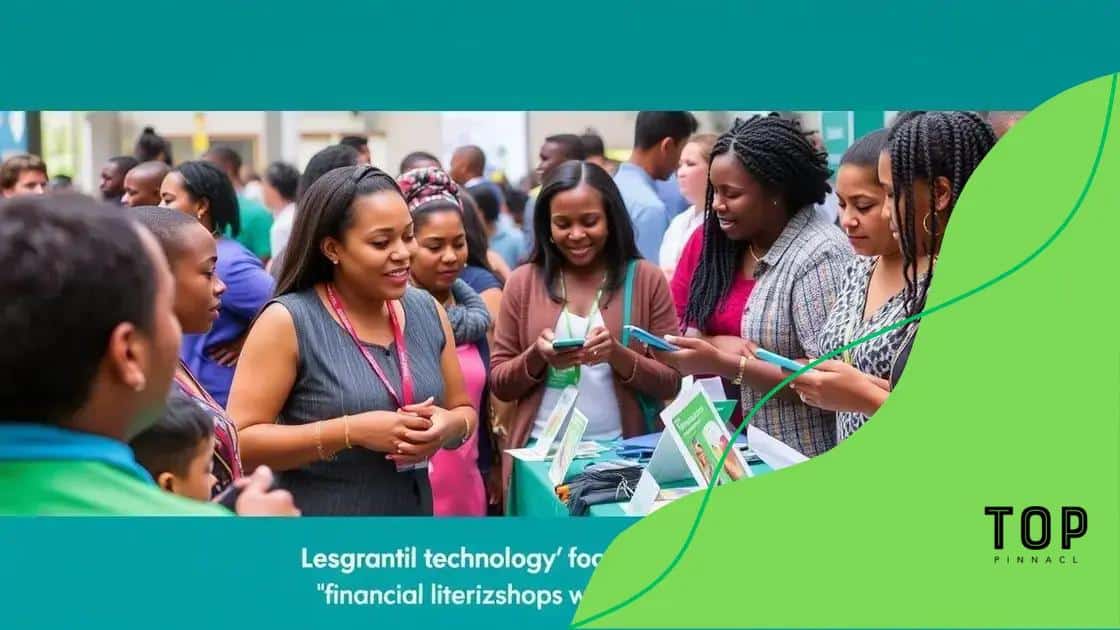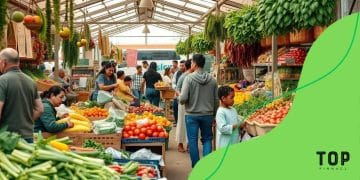Consumer banking access in underserved areas is crucial
Consumer banking access in underserved areas significantly improves financial inclusion by leveraging technology, community initiatives, and tailored solutions to remove barriers and empower individuals economically.
Consumer banking access in underserved areas is a pressing issue that can significantly impact lives. How often do we consider those who lack basic banking services? This article delves into the various aspects surrounding this topic.
Understanding consumer banking needs
Understanding consumer banking needs is essential for developing effective financial services. Many individuals, especially in underserved areas, face unique challenges that affect their access to banking. By identifying their specific needs, banks can create solutions that foster inclusivity and empower communities.
Key Factors Influencing Banking Needs
Various factors influence the banking needs of consumers. Some of the most significant aspects include:
- Demographics: Age, income, and education level play a big role in how individuals interact with financial institutions.
- Financial literacy: Understanding basic financial concepts is crucial for effective use of banking services.
- Technology access: The availability of smartphones and internet connectivity can greatly impact how consumers engage with banks.
Moreover, many people in underserved areas may not have a bank account at all. This gap indicates a need for products that cater specifically to those who are not traditionally served by banks. Options such as prepaid cards or mobile banking apps can help bridge this gap.
What Consumers Value in Banking
When we look at what consumers value most, we notice several key areas:
- Accessibility: People want to access their financial services easily, particularly in their local communities.
- Affordability: Low fees and fair interest rates are priorities for consumers working with tight budgets.
- Customer service: Personal connections and community support can significantly enhance the banking experience.
Creating personalized banking options can lead to greater trust and loyalty among clients. Banks that understand and implement these strategies will likely see an increase in customer satisfaction.
The evolving landscape of consumer banking is shaped by ongoing trends and challenges. Recognizing these elements and adjusting services is vital for continuous improvement. By focusing on consumer needs, banks can foster a more inclusive and supportive financial environment for all.
Barriers to banking in underserved areas
There are significant barriers to banking in underserved areas that prevent individuals from accessing essential financial services. These obstacles can be complex and vary from community to community, but understanding them is a critical step toward improving access.
Common Barriers
Some of the major barriers include:
- Geographical limitations: Many underserved areas are located far from traditional bank branches, making it difficult for residents to access services.
- Financial literacy: A lack of knowledge about banking products and services can discourage individuals from seeking assistance.
- Cost of services: High fees and minimum balance requirements can exclude low-income individuals from banking opportunities.
Furthermore, trust issues can arise from negative past experiences with financial institutions. When people feel their needs are not being met, they may avoid banking altogether. This reluctance is particularly pronounced in communities with high rates of poverty.
Impact of These Barriers
The impact of these barriers is profound. Without access to banking, individuals miss out on building credit and saving for the future. Many resort to using cash, which can be less secure and limit their ability to make larger purchases or investments.
Community support plays a pivotal role in overcoming these challenges. Local organizations can help raise awareness about available banking options, bringing education and resources directly to individuals. Collaborations between banks and community groups offer promising avenues for enhancing access.
In addition, innovative banking solutions, such as mobile banking apps, offer an alternative way for underserved populations to engage with financial services. These technologies can help bridge the gap where traditional banking fails.
Innovative solutions promoting banking access

Innovative solutions play a vital role in promoting banking access for underserved populations. These creative approaches can address many of the barriers that individuals face in accessing financial services. By leveraging technology and community resources, banks can create pathways for greater financial inclusion.
Mobile Banking Technologies
One of the most significant advancements in banking is mobile technology. Mobile banking apps allow individuals to manage their finances directly from their smartphones. This accessibility is crucial for those who may not have easy access to physical bank branches.
- Convenience: Users can perform transactions anytime, anywhere, making banking more flexible.
- Low cost: Many mobile banking services have low fees compared to traditional banks.
- Real-time access: Individuals can track spending and savings in real-time, helping them make informed financial decisions.
As mobile banking continues to expand, it significantly enhances consumer banking access, especially in remote areas where traditional banking services may be scarce.
Community Partnership Programs
Community partnerships are another powerful solution. Banks can collaborate with local organizations to increase awareness of banking options. These partnerships enable them to address specific community needs.
Programs could include:
- Financial literacy workshops to educate individuals about managing their money.
- In-person support at community events, where residents can learn about banking products.
- Collaborative marketing campaigns to promote new services.
By working directly with communities, banks can build trust and encourage more people to utilize banking services.
Additionally, offering products that cater specifically to low-income individuals, such as no-fee checking accounts and savings programs, can also promote greater participation in the banking system. These tailored solutions can transform the way underserved individuals view and engage with financial institutions.
The role of technology in financial inclusion
The role of technology in financial inclusion is transforming how underserved populations access banking services. Technology provides tools that make financial services more accessible and affordable for everyone. By bridging gaps, it empowers individuals to participate in the economy.
Digital Banking Solutions
Digital banking solutions are at the forefront of this transformation. With the rise of smartphones and internet access, many people can open bank accounts without visiting a physical branch. Digital platforms offer the convenience that traditional banking often lacks.
- Easy account setup: Users can open accounts online in minutes with just a few clicks.
- Lower fees: Online banks usually operate with fewer overhead costs, allowing them to offer better rates.
- 24/7 access: Digital banking allows customers to manage their finances at their convenience.
These features make digital banking an attractive option, especially for those who have previously struggled with traditional banking methods.
The Impact of Fintech Innovations
Fintech innovations are changing the landscape of financial services. Applications offering budgeting tools and personalized financial advice are becoming popular among users. Such technologies help consumers track their spending and savings more effectively.
Moreover, fintech companies are creating products designed specifically for low-income users. These services help reduce or eliminate fees, making banking more affordable. By offering tailored solutions, fintechs tackle barriers that have historically excluded many from the banking system.
As technology advances, it continuously enhances financial literacy among consumers. Users can access educational resources directly through their banking applications. This knowledge is crucial for making informed financial decisions, especially for those who may have been overlooked in the past.
Community initiatives supporting banking access
Community initiatives supporting banking access play a crucial role in promoting financial inclusion. These initiatives often focus on educating individuals about financial services and providing resources to help them overcome obstacles to banking.
Workshops and Education Programs
Many communities organize workshops that teach residents about managing finances, understanding credit, and utilizing banking services. These programs aim to build financial literacy and empower individuals.
- Basic budgeting: Workshops can help people learn how to create and stick to a budget.
- Credit education: Learning how credit works and how to improve credit scores is vital.
- Banking products: Education on savings accounts, loans, and other services increases awareness and usage.
By improving financial literacy, communities can help residents make informed choices about their financial futures.
Partnerships with Local Organizations
Collaborating with local organizations is another effective strategy. Banks can partner with schools, nonprofits, and community groups to broaden their outreach. This collaboration allows for tailored programs that meet specific community needs.
Some effective partnership strategies include:
- Offering free financial counseling: Partnerships can provide experts who offer assistance and advice to those in need.
- Creating outreach programs: Banks can organize events in local neighborhoods where residents can learn about banking options directly.
- Promoting community events: Sponsoring local events can increase visibility and engagement.
By working with trusted community groups, banks can foster trust and encourage greater participation in financial systems.
Moreover, these initiatives not only improve banking access but also strengthen the entire community. As individuals gain the knowledge and tools they need, they feel more confident in their financial decisions.
In summary, enhancing consumer banking access in underserved areas requires a multifaceted approach that combines innovative technology, community initiatives, and tailored banking solutions. By removing barriers and fostering financial literacy, we can empower individuals to participate in the financial system. As banks collaborate with local organizations and embrace digital solutions, they create a path toward greater financial inclusion for everyone. Together, we can build stronger communities where everyone has the opportunity to thrive.
FAQ – Frequently Asked Questions about Consumer Banking Access in Underserved Areas
What are the main barriers to banking in underserved areas?
Major barriers include geographical limitations, lack of financial literacy, and high costs associated with banking services, which prevent access.
How can technology improve banking access?
Technology, particularly mobile banking applications, allows individuals to manage finances easily, reducing the need for physical bank visits.
What role do community initiatives play in banking access?
Community initiatives provide education and resources, helping individuals understand financial services and promoting trust in banking.
What are tailored banking solutions?
Tailored banking solutions are customized products designed to meet the specific needs of low-income individuals and underserved populations.






